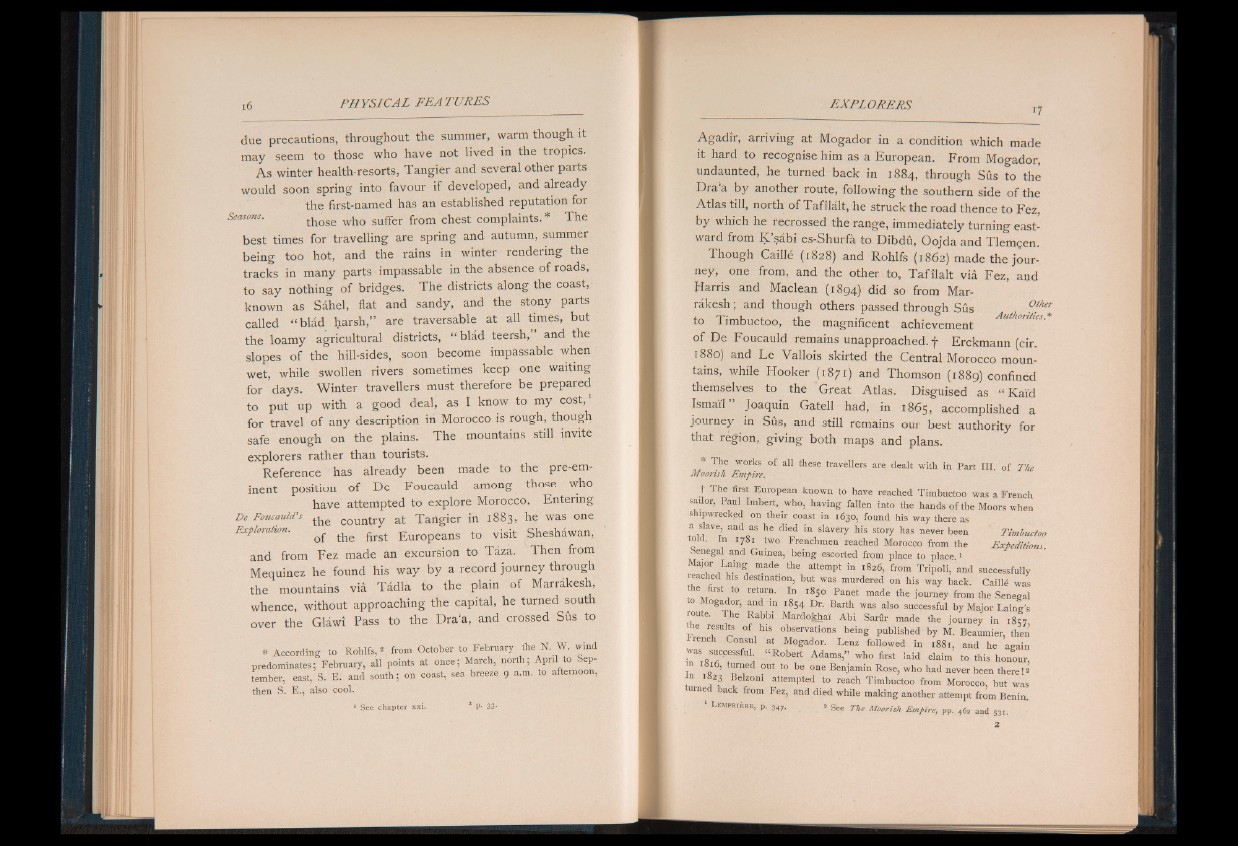
PH Y SICA L FEA TU R E S
due precautions, throughout the summer, warm though it
may seem to those who have not lived in the tropics.
A s winter health-resorts, Tangier and several other parts
would soon spring into favour if developed, and already
the first-named has an established reputation for
Seasons. those whQ suffer from chest complaints.* The
best times for travelling are spring and autumn, summer
being too hot, and the rains in winter rendering the
tracks in many parts .impassable in the absence of roads,
to say nothing of bridges. The districts along the coast,
known as Sahel, flat and sandy, and the stony parts
called “ blad harsh,” are traversable at all times, but
the loamy agricultural districts, “ blad teersh,” and the
slopes of the hill-sides, soon become impassable when
wet, while swollen rivers sometimes keep one waiting
for 'days. Winter travellers must therefore be prepared
to put up with a good deal, as I know to my cost,
for travel of any description in Morocco is rough, though
safe enough on the plains. The mountains still invite
explorers rather than tourists.
Reference has already been made to the pre-eminent
position of De Foucauld among those who
have attempted to explore Morocco. Entering
De Foucauld'S the country at Tangier in 1883, he was one
Exploration. ^ ^ firgt Europeans to visit Sheshawan,
and from Fez made an excursion to Taza. Then from
Mequinez he found his way by a record journey through
the mountains via Tddla to the plain of Marrakesh,
whence, without approaching the capital, he turned south
over the Glawi Pass to the Dra'a, and crossed Sus to
* According to Rohlfs,*, from October to February the N. W. wind
predominates; February, all points at once; March, north; April to September,
east, S. E. and south; on coast, sea breeze 9 a.m. to afternoon,
then S. E., also cool.
1 See chapter xxi. 2 P- 33-
EXPLORERS
Agadir, arriving at Mogador in a condition which made
it hard to recognise him as a European. From Mogador,
undaunted, he turned back in 1884, through Sûs to the
Dra’a by another route, following the southern side of the
Atlas till, north of Tafilalt, he struck the road thence to Fez,
by which he recrossed the range, immediately turning eastward
from K ’sàbi es-Shurfà to Dibdû, Oojda and Tlemçen.
Though Caillé (1828) and Rohlfs (1862) made the journey,
one from, and the other to, Tafilalt viâ Fez, and
Harris and Maclean (1894) did so from Marrakesh
; and though others passed through Sus 0t.,ur
to Timbuctoo, the magnificent achievement Authorities-
of De Foucauld remains unapproached, f Erckmann (cir.
1880) and Le Vallois skirted the Central Morocco mountains,
while Hooker (1871) and Thomson (1889) confined
themselves to the Great Atlas. Disguised as “ Kaïd
Ismail Joaquin Gatell had, in 1865, accomplished a
journey in Sûs, and still remains our best authority for
that region, giving both maps and plans.
4 The works of all these travellers are dealt with in Part III. of The
Moorish Empire.
t The first European known to have reached Timbuctoo was a French
sailor, Paul Imbert, who, having fallen into the hands of the Moors when
shipwrecked on their coast in 1630, found his way there as
a slave and as he died in slavery his story has never been Timbuctoo
told. In 1781 two Frenchmen reached Morocco from the Expeditions.
benegal and Guinea, being escorted from place to place.1
Major Laing made the attempt in 1826, from Tripoli, and successfully
reached his destination, but was murdered on his way back. Caillé was
, l0u ^ return- Id i85° Panet made the journey from the Senegal
o Mogador, and in 1854 Dr. Barth was also successful by Major Laing’s
route. he Rabbi Mardokhai Abi Sarur made the journey in 1857
hie results of his observations being published by M. Beaumier, then
french Consul at Mogador. Lenz followed in 1881, and he again
was successful «Robert Adams,” who first laid claim to this honour,
mi l , turned out to be one Benjamin Rose, who had never been there!*
1 n x , „Z°ni attemPted to reacîl Timbuctoo from Morocco, but was
urne ack from Fez, and died while making another attempt from Benin.
1 Lempr1uRe, p. 347. 2 See The Moorish Empire, pp, 462 and 531.